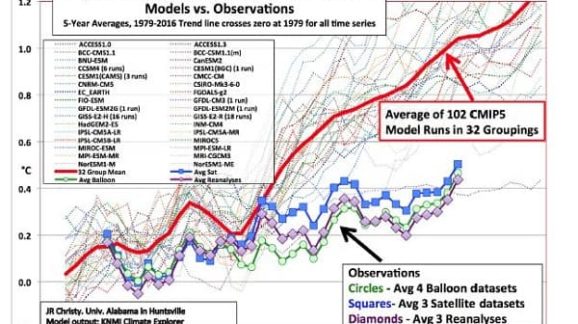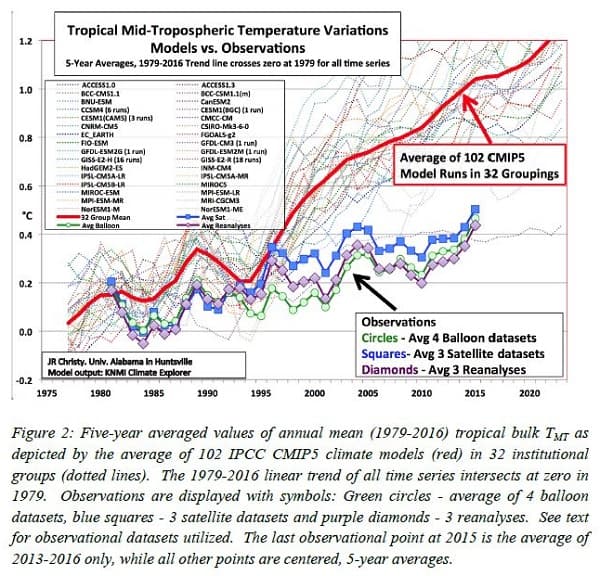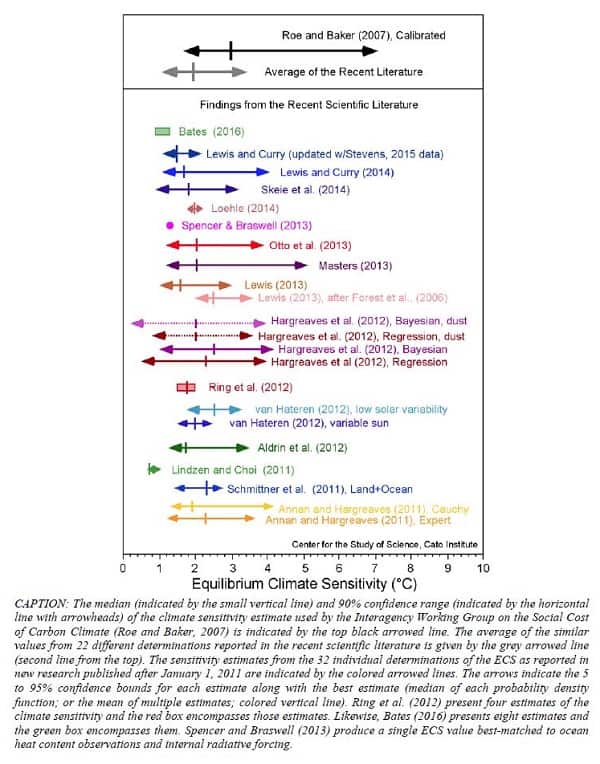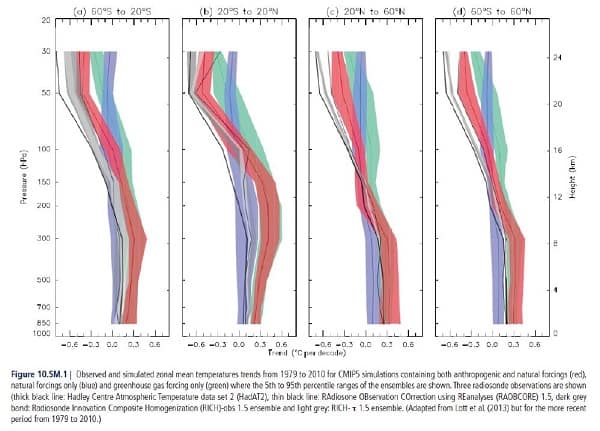Capitol Hill Climate Science Dispute Yields Advantage to Skeptics

Earlier this week, American Meteorological Society (AMS) executive director Keith Seitter implicitly accused House Science Committee Chairman Lamar Smith (R-TX) of retailing unscientific climate denialism. At the Committee’s hearing last week on climate science and the scientific method, University of Alabama in Huntsville atmospheric scientist John Christy provided observational evidence inconsistent with the alleged “consensus” that more than half of recent global warming is due to human activity. In a letter to Chairman Smith dated April 3, Seitter writes:
We can now say with very high levels of confidence, based on literally thousands of independent research efforts and multiple independent lines of evidence, that most of the warming our planet has experienced over the past 50 years is due to human activity. Indeed, to suggest that humans are not responsible for most of the warming we have experienced over the past 50 years indicates a disregard for the scientific process and the vast amount of testable evidence that has been amassed on this subject.
Seitter explains the “community’s” high confidence in that assessment:
The scientific community has learned a great deal about Earth’s climate system over the past several decades, applying the scientific method rigorously to data analysis and to understanding the physical processes that affect global temperature and other aspects of climate change. Hypotheses have been developed and tested through scientific experiments. The results are then systematically challenged and synthesized through open debate in scientific conferences and the peer-reviewed literature.
However, Seitter does not describe any of those experiments that supposedly identify human activity as responsible for more than half of recent warming. He stresses that a “fundamental aspect of science is prediction,” citing astronomers’ ability to forecast solar eclipses, but does not cite a single example of comparable predictive success in climate science.
Christy, as we will see, builds his argument on testable hypotheses and the failure of climate model predictions to match data. At no point does Seitter address or even acknowledge Christy’s observational tests.
So Seitter’s criticism boils down to ‘trust us, we’re the experts.’ While invoking the scientific method, he serves up the same old argument from authority—a rhetorical tactic that is off-putting to inquiring minds and partly responsible for the growth of climate change skepticism. Must a scientist check his self-awareness and sense of irony at the door to enter the temple of consensus climatology?
Christy begins his testimony by describing the scientific method:
“Science” is not a set of facts but a process or method that sets out a way for us to discover information and which attempts to determine the level of confidence we might have in that information. In the method, a “claim” or “hypothesis” is stated such that rigorous tests might be employed to test the claim to determine its credibility. If the claim fails a test, the claim is rejected or modified then tested again.
There are basically three key issues in climate change science: detection (has warming occurred and if so how much?), attribution (what portion of recent warming is due to human activity rather than natural variability?), and sensitivity (how much warming will result from a doubling of greenhouse gas concentration?). In layman’s terms, what happened, who done it, and what can we reasonably predict?
The claims of consensus science on those issues are embodied in the mammoth U.N. Intergovernmental Panel Climate Change (IPCC) reports, the latest being the 2013 Fifth Assessment Report (AR5). The three issues have varying degrees of controversy. All scientists agree that global warming has occurred since 1950, although significant disputes remain about exactly how much and which datasets are more reliable. Climate sensitivity is an active area of research, with growing evidence that IPCC climate models are overheated. At least some scientists—among them Christy—challenge the IPCC’s canonical claim to possess greater-than-95-percent certainty that more than half of recent warming is human-caused (AR5, p. 17).
Christy summarizes his results as follows:
When the “scientific method” is applied to the output from climate models of the IPCC AR5, specifically the bulk atmospheric temperature trends since 1979 (a key variable with a strong and obvious theoretical response to increasing GHGs in this period), I demonstrate that the consensus of the models fails the test to match the real-world observations by a significant margin. As such, the average of the models is considered to be untruthful in representing the recent decades of climate variation and change, and thus would be inappropriate for use in predicting future changes in the climate or for related policy decisions.
Christy’s finding that model predictions overshoot observations is undeniable. The chart below compares the mean warming projections of 102 model runs with the means of 10 independent observational datasets since the start of the satellite record in 1979.

To any unbiased person, the chart above suggests that most models are tuned too hot and exaggerate climate sensitivity. Based on such data, several recent studies find a lower sensitivity—and a more tightly constrained sensitivity range—than “consensus” science estimated when the IPCC issued its 2007 Fourth Assessment Report (AR4):

Christy also presents observational evidence that calls into question the IPCC’s attribution assessment. Ironically, the evidence is in AR5, although tucked away and not discernible to the untrained eye.
Why, according to the IPCC, is it “extremely likely” that most recent warming is anthropogenic? Supposedly, because climate simulations match observations only when the models are run with both known natural variability and anthropogenic emissions rather than with natural variability alone. Christy, however, observes that a chart in AR5, which is “buried . . . without comment” in supplementary material, furnishes contrary evidence.
The chart as it appears in AR5—panel (b) in Figure 10.SM.1—depicts model projections and observed temperatures in the tropical troposphere—the bulk atmosphere between 20 degrees south and 20 degrees north of the equator. The tropical troposphere is where much of the sun’s radiant energy enters the climate system and drives critical heat and moisture processes.

In the IPCC chart, it is hard to make out what’s going on in panel (b). However, after Christy magnifies and clarifies it, we can see that simulations match observations only when the models are run with natural variability alone.

During 1979-2011, the range of observed temperatures in the tropical troposphere (the area between the gray lines) falls within the range of climate simulations from models run with natural variability only (the area between the blue lines) but outside the range of model simulations run with both natural variability and greenhouse gas emissions (the area between the red lines).
In other words, the IPCC’s own data imply that natural variability accounts for all warming of the bulk tropical atmosphere since 1979. Christy concludes:
What is immediately evident is that the model trends in which extra GHGs [greenhouse gases] are included lie completely outside of the range of the observational trends, indicating again that the models, as hypotheses, failed a simple “scientific-method” test applied to this fundamental, climate-change variable. That this information was not clearly and openly presented in the IPCC is evidence of a political process that was not representative of the dispassionate examination of evidence as required by the scientific method. Further, (and this took guts) the IPCC then claimed high confidence in knowing why the climate evolved as it did over the past few decades (humans as the main cause) ignoring the fact the models on which that claim was based had failed an obvious and rather easy-to-perform validation test. Incredibly, what Fig. 5 shows is that the bulk tropical atmospheric temperature change is modeled best when no extra GHGs are included—a direct contradiction to the IPCC conclusion that observed changes could only be modeled if extra GHGs were included.
As noted, none of this information is acknowledged, much less addressed in Seitter’s letter to chairman Smith. Seitter’s innuendo that Christy showed “disregard for the scientific process and the vast amount of testable evidence that has been amassed on this subject” is hand waving and rhetorical bluster. Such behavior can only increase public skepticism about those who attack climate “skeptics.” Thank you, Dr. Seitter!